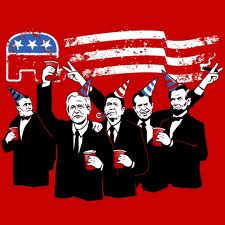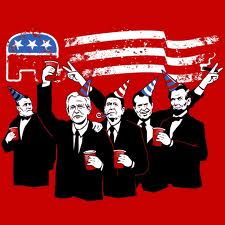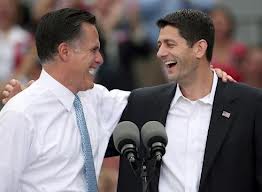 THE TEA PARTY PHENOMENA: “Do we really want to subsidize the losers’ mortgages?” CNBC’s Rick Santelli asked while standing on the floor of the Chicago Mercantile Exchange on February 19, 2009. “This is America! How many of you people want to pay for your neighbor’s mortgage that has an extra bathroom and can’t pay their bills?” Santelli went on to suggest that he would organize a Chicago Tea Party in July, where capitalists would dump “some derivative securities into Lake Michigan.” The video of his tirade became a YouTube hit, and thus the Tea Party was born. Within weeks, Tea Party protests were sprouting up all over the place. The Tea Party name, a clear reference to the American colonists’ dumping of tea into Boston Harbor to protest taxes imposed by King George, stands as an acronym as well: Taxed Enough Already.
THE TEA PARTY PHENOMENA: “Do we really want to subsidize the losers’ mortgages?” CNBC’s Rick Santelli asked while standing on the floor of the Chicago Mercantile Exchange on February 19, 2009. “This is America! How many of you people want to pay for your neighbor’s mortgage that has an extra bathroom and can’t pay their bills?” Santelli went on to suggest that he would organize a Chicago Tea Party in July, where capitalists would dump “some derivative securities into Lake Michigan.” The video of his tirade became a YouTube hit, and thus the Tea Party was born. Within weeks, Tea Party protests were sprouting up all over the place. The Tea Party name, a clear reference to the American colonists’ dumping of tea into Boston Harbor to protest taxes imposed by King George, stands as an acronym as well: Taxed Enough Already.
Rick Santelli, however, can’t claim credit as the sole mastermind of the Tea Party movement. Before Santelli’s appearance in Chicago, Keli Carender, a Seattle at-home mom also known as Liberty Belle, had been using her blog to get the word out about the populist “Porkulus Protest” she was organizing against President Obama’s proposed $750 billion stimulus package. About 100 people showed up for her. Similar events inspired by both Santelli and Carender followed in Denver; Mesa, Ariz.; Tampa, Fla.; and other cities. Tea Party organizers claim that the first nationwide Tea Party protest took place on February 27, 2009, with coordinated events occurring in more than 40 cities. The Tea Party movement claims no national leader or figurehead although some say that Sarah Palin assumed that role when she delivered the keynote address at the first Tea Party Convention in February 2010, in Nashville. Some 600 people attended the full convention and another 500 sat in on Palin’s speech only. “America is ready for another revolution,” she said. Palin also said that the movement is “about the people, and it’s bigger than any one king or queen of a tea party, and it’s a lot bigger than any charismatic guy with a teleprompter” referring to President Obama. The Tea Party movement claims to be a grassroots movement but FreedomWorks, a powerful conservative organization headed by former congressman Dick Armey, seems to play an important role behind the scenes and serves as clearinghouses for information on protests.
While Democrats are usually the target of the Tea Party rage, Republicans have not always been spared. For example, in New York, many Tea Party members endorsed third-party candidate Doug Hoffman in the 2009 special election for the House seat vacated by John McHugh, over the moderate Republican candidate, Dede Scozzafava, pro-choice and a backer of gay marriage. Their plan backfired: Scozzafava withdrew from the race and Democrat Bill Owens narrowly won that election.
The ranks of Tea Party members grew in Congress throughout 2010. The movement’s first major victory of the year occurred in January 2010, in Massachusetts when Republican Scott Brown defeated Democrat Martha Coakley in the Senate race to fill the seat vacated after the death of Sen. Ted Kennedy. Brown tried to distance himself from the Tea Party during the race, but as he positioned himself as an outsider who would vote to block health-care reform, the movement claimed him as one of their own. In July 2010, Republican Representative Michele Bachmann got the go-ahead from House Leader Boehner to form a Tea Party Caucus. Twenty-eight Republicans joined the group. In the November 2010 midterm elections, voters elected Kentucky’s Rand Paul and Florida’s Marco Rubio to the Senate. However, voters rejected some high-profile Tea Party candidates including Delaware’s Christine O’Donnell, a conservative and controversial social activist, who upset highly regarded political veteran Representative Mike Castle in the September primary, was defeated in the general election by Democrat Christopher Coons. Sharron Angle, another controversial Tea Party member lost her bid to unseat Senate Majority Leader Harry Reid.
The Tea Party movement has significantly altered the political landscape and has been instrumental in the 12% approval rating of Congressional Republicans. The overall result is that the Party of Lincoln is no longer a Party of Lincoln and it has gone so far to the right that the Party has established a reputation of being against women’s rights, voter rights, gay rights and citizenship rights to name a few.
CONTINUED IN PART III

